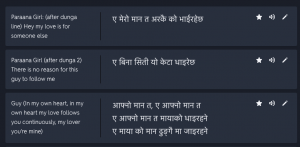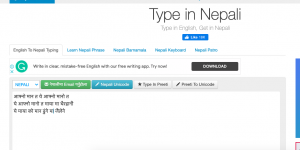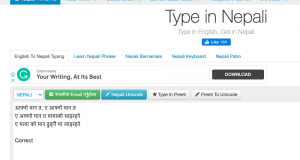Nepali
Online Resources Example: Learning Nepali Lyrics
I have been using Easy Nepali Typing to work on my Devanagari writing while typing, as I can copy and paste it into Anki or Quizlet as needed. I have also used this online site to type up my interview questions and material for the Pressbooks updates. So, I wanted to show how I use it daily to translate one lyric from a Nepali song (almost) every day. The Nepali songs on YouTube are another online source that I have been using for cultural listening immersion in Nepali. I usually check over my translations and understanding with my language mentor, as there are lots of idioms and figures of speech used in Nepali songs! They are very rich in this regard, so this (almost) daily task has been very beneficial for me to both learn the language and cultural cues and context. So, here is the song Paraana, which is sung by Ashish Aviral and Anju Panta. Hom-ji has actually met Anju Panta before, which is so cool!! She has an amazing voice. Anmol KC & Suhana Thapa are the actors featured in this music video, as this song is from a Nepali movie called “A Mero Hajur 3.” Not all Nepali YouTube music videos have closed captions in English, but this one does. However, I only used this as a last resort because the direct translation from Nepali to English can sometimes be skewed.
Here is how I engaged with the video and Easy Nepali Typing:
- Watch/listen to music video several times.
- Pull out lyric (close to chorus) to interpret.
- Look up written lyrics in Nepali (I used this site for the song Paraana).
- Practice typing into Easy Nepali Typing.
- Put words into Nepali –> English on Google Translate to check for correct spelling and understanding.
- Rewrite in Easy Nepali Typing as necessary (if Google Translate does not recognize the words, check for different spelling).
- Look at the translation on the closed captions.
- Once you feel good about the accuracy of the written lyrics/my general understanding of the meaning, create an Anki card (or Quizlet card) to recall the whole lyric.

- Practice this everyday/according to Anki’s system.
- Practice singing along with the music video in full speed.
- Check with Hom-ji for pronunciation/translation!
Some Important Notes:
Step 4: It is very important to remember that just typing the lyrics directly into Easy Nepali Typing will not always be accurate!! See the difference in spelling in the first screenshot (direct copy and paste from the lyrics website) versus once the meaning and spelling of the words is explored and checked. Pretty different! This is one of the difficulties in learning Nepali Devanagari along with the Romanized alphabet version. The Romanized alphabet is used so differently when trying to represent the Devanagari spelling that it can be very confusing!



Step 11: This last step of checking for understanding with my language mentor is very crucial!! For instance, the second line of this song took an idiom and changed it slightly to add humor! The idiom states how parents constantly think and care about their children, whereas children’s thoughts are worthless or careless. The direct translation is something along the lines of how parents’ love is always above their children (or that they are always thinking about their children), whereas children’s love and thinking are always going into a rock, or for someone else. So, this idiom references the rock as being where the man’s love keeps going. This is then translated to that his lover is his (so it’s a play on the idiom!)
Bonus: You learn new vocabulary!! For instance, I did not know the word “dhaaunu” which means to follow continuously. It is used in the second verse of Paraana to express how the man’s heart will endlessly follow the girl. Hom-ji then explained to me how this verb can be used when farmers take care of their fields continuously, such as “kheti dhaaune,” so there are many benefits of learning lyrics to songs that extend beyond just the song itself!

